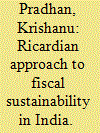| Srl | Item |
| 1 |
ID:
148505


|
|
|
|
|
| Summary/Abstract |
This study is an attempt to model the linkages between stock market development and economic growth in developed and emerging markets. The causality direction between stock market development and economic growth has also been examined in order to provide solid policy implications. Mainly, the relationship and direction of causality between stock market development and economic growth were tested using dynamic panel data analysis based on the Generalised Methods of Moment (GMM) and panel Granger non-causality, respectively. Additionally, panel unit root tests were also applied to check the stationary of the selected variables to avoid misleading results. The study focuses on 20 countries, both developed and emerging markets, and data were collected over the period 1990–2014 mainly from World Bank data series. Dynamic panel data analysis confirms that there is a statistically significant relationship between stock market development and economic growth in both developed and emerging markets. Further, the study emphasises that only the finance-led growth hypothesis is valid for emerging markets while developed markets support bidirectional causality between stock market development and economic growth, reflecting the existence of both the finance-led growth hypothesis and the growth-led finance hypothesis. Hence, it is crucial to formulate appropriate policies to shift unproductively allocated funds towards stock markets to meet long-term capital requirements to encourage higher economic growth.
|
|
|
|
|
|
|
|
|
|
|
|
|
|
|
|
| 2 |
ID:
148506


|
|
|
|
|
| Summary/Abstract |
Food security is a basic requirement of livelihood. A major source of calories is carbohydrates which are mainly derived from foodgrains. This article addresses the foodgrain deficiency in India, across its states, regions and at the household level. The study further analyses the causal effect of subsidies from India’s public distribution system, the share of home-produced foodgrain in total consumption of foodgrains, food diversification, monthly per capita consumption expenditure and socio-religious factors on foodgrain deficiency. The analysis is based on the National Sample Survey’s unit-level data at three points of time: 1999–2000, 2004–05 and 2009–10. Foodgrain deficiency has been captured at the national level and across states by suitably adapting Foster, Greer and Thorbecke’s (1984) measure of poverty. Panel regression has been done at the state-region level to analyse the impact of the above-mentioned determinants on foodgrain deficiency. For the household-level regression, the dependent variable is deviation from the desired norm of 8.6 kg of foodgrain per consumer unit per month. Quantile regression analysis is done at the household level to capture the impact of the determinants at different segments of foodgrain deviations. We find that foodgrain deficiency levels have increased for ‘all-classes’ and the ‘below-poverty-level class’ but the deficiency levels are not very high and can be managed with suitable measures. It is further found that the determinants have a significant influence on foodgrain deficiency and foodgrain deviation at the state-region and household levels, respectively. Suitable policy measures have also been identified.
|
|
|
|
|
|
|
|
|
|
|
|
|
|
|
|
| 3 |
ID:
148504


|
|
|
|
|
| Summary/Abstract |
The purpose of this article is to deepen the understanding of informality, and related efforts governments must take to cope with large and persistent informal sectors. Is the informal sector a source of growth and employment or a drain on the fiscus that undermines social safety nets? This article questions the ‘formal sector bias’ present in much of the policy discussions surrounding informality. A theoretically grounded distinction between ‘functional’ and ‘juridical’ informality is drawn and applied to subcontracting as an illustrative case. The broad conclusion of the paper is not supportive of public intervention to formalise the informal sector but rather suggests that tolerating the informal sector might well improve economic performance as measured by output and employment.
|
|
|
|
|
|
|
|
|
|
|
|
|
|
|
|
| 4 |
ID:
148507


|
|
|
|
|
| Summary/Abstract |
There are several approaches to assessing the sustainability of a country’s public finances. Ricardian equivalence is one such approach, in which fiscal sustainability is defined in terms of the neutrality of generational welfare through government fiscal policy. The present work is an attempt to discuss and analyse fiscal sustainability in India in the context of Ricardian equivalence. Different forms of empirically testable equations for testing Ricardian equivalence are derived based on studies by Buiter and Tobin (1978), Kormendi (1983) and Kormendi and Meguire (1990). A key aspect of fiscal sustainability is to ensure generational equity as reflected in India’s Fiscal Responsibility and Budget Management (FRBM) Act, 2003. Based on availability of data, empirical evidence is against the presence of Ricardian equivalence, indicating that the fiscal policy India pursued during the study period (1974–2011) has been detrimental to generational welfare neutrality.
|
|
|
|
|
|
|
|
|
|
|
|
|
|
|
|